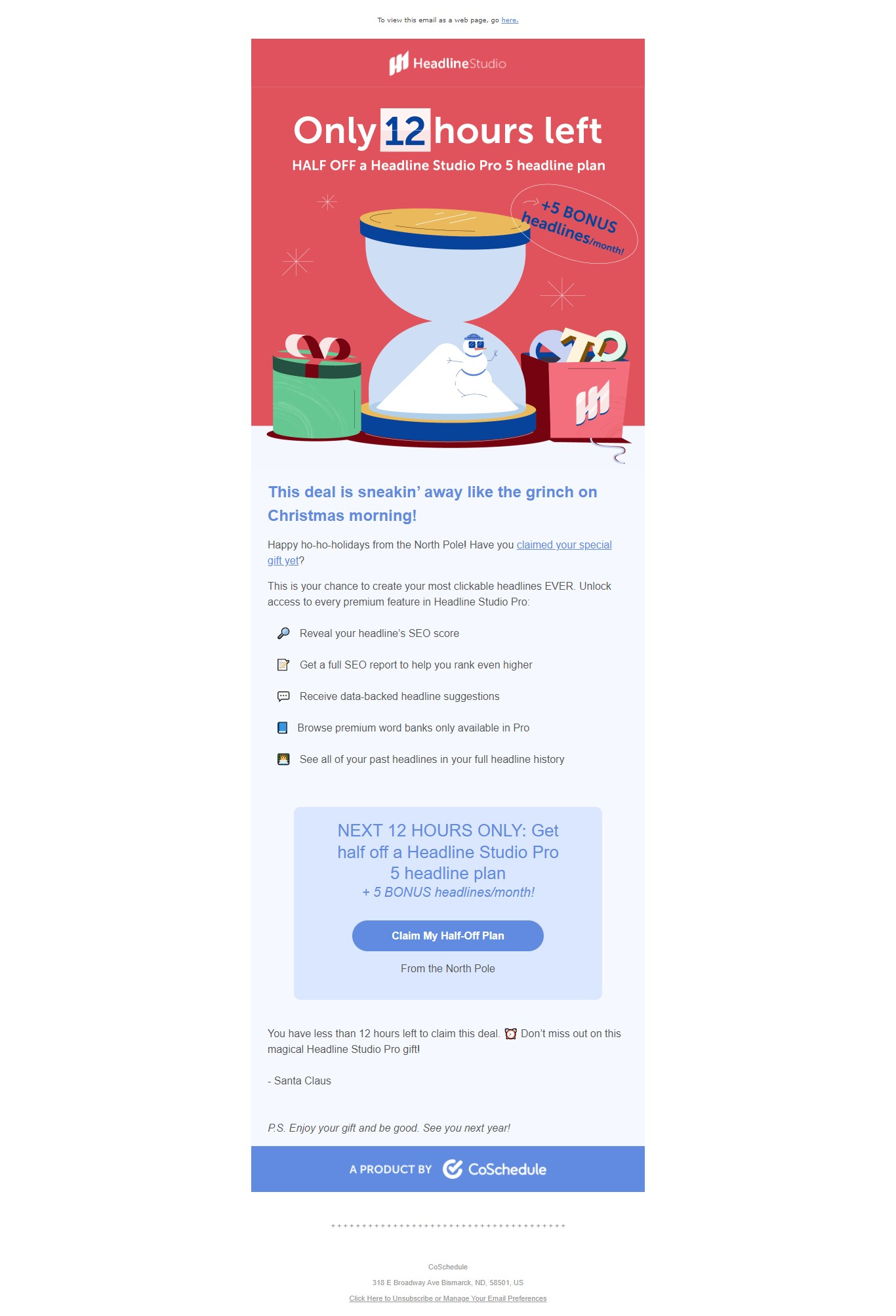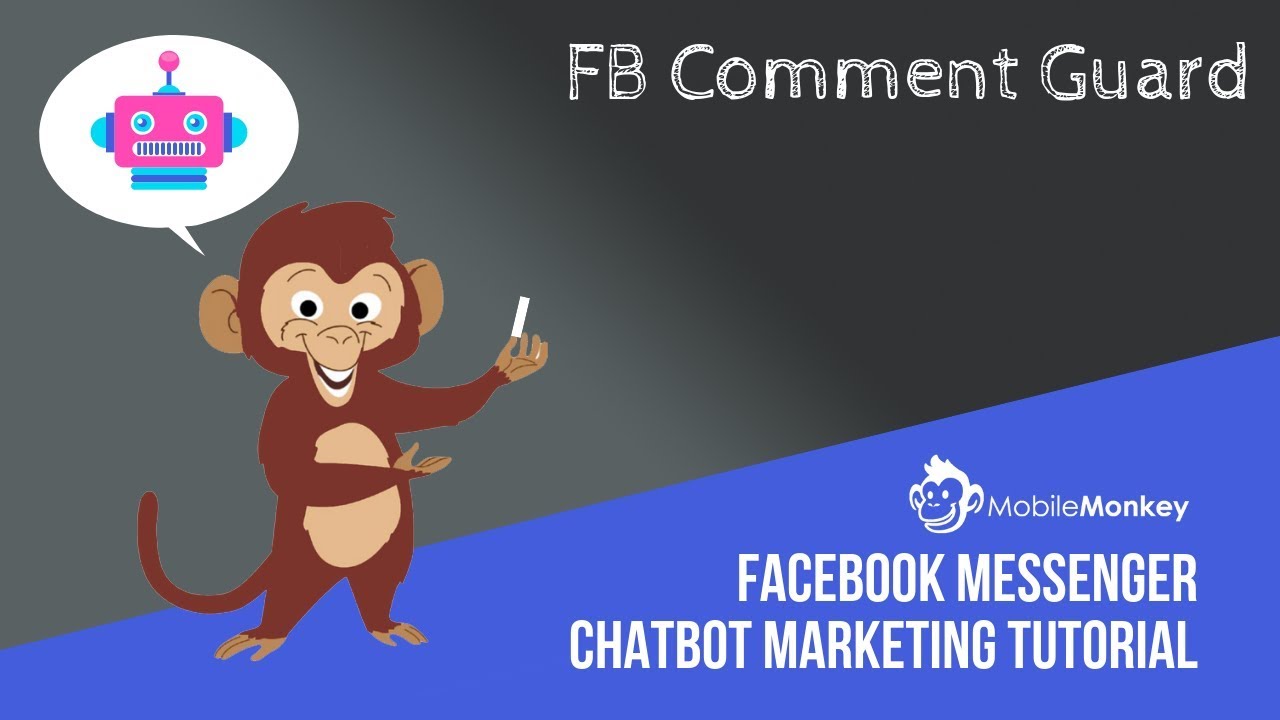5 fast ways to generate leads on your website
Generating leads is one of the most important responsibilities of marketers in every industry. Without leads, there are no sales, and without sales, the business doesn’t survive.
So how do you generate leads fast using your most important resource: your website?
5 fast ways to generate leads on your website
- Giveaways
- Discounts
- Downloads
- Gamification
- Referral programs
Let’s break the list down and see how you can leverage every one of them to get leads for your business. If you’re looking for other ways to get leads, here are two ideas for you to explore: 3 efficient lead-generation tools and conversational marketing.
1. Giveaways
Giveaways are a great way to generate leads on your website.
What should you do to generate leads through giveaways?
You do a brainstorming session with your marketing and sales team and come up with a few ideas of what your prospects would like to receive in exchange for their email.
To turn prospects (potential customers fitting certain criteria) into leads (prospects sharing contact information with your company), your giveaway has to comply with a set of requirements.
First of all, your giveaway can be one of your products or services. If that’s not possible, your giveaway can be anything that speaks to your brand values and is in line with your customers’ interests.
Here’s an example:
Beauty and makeup brands give away beauty products, but they could also give away a makeup session with a renowned makeup professional or a skincare course with a dermatologist.
Once you have decided upon the prize you are going to give your prospects, it’s time to create a dedicated landing page on your website.
The architecture of your landing page should include the following elements:
- An eye-candy or an appealing image of your prize;
- Powerful headline;
- Enticing body copy;
- Description of your prize;
- How your prospects would benefit from your prize, when applicable;
- Contact information form for your lead’s name and mail address;
- CTA button;
- One or two questions you would like your lead to answer (refrain from including too many questions or asking for too much information);
- The time period over which your giveaway will take place (at least 7 days);
- When and how you will choose the winner/s;
- How you will announce and contact the winner.
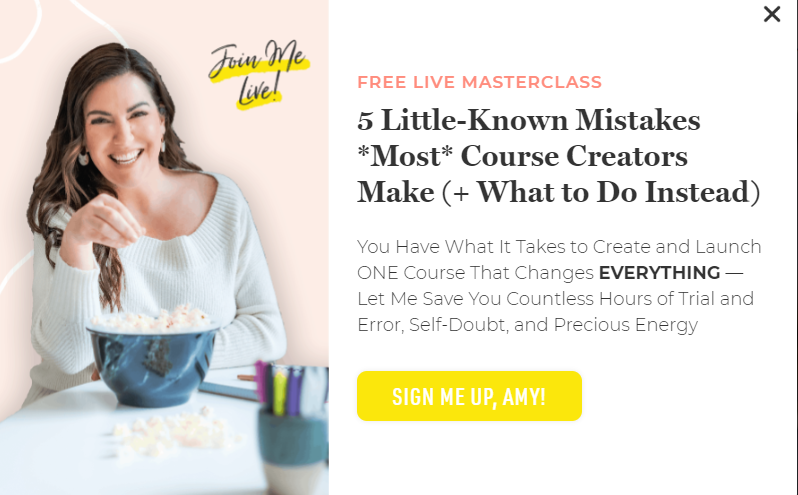
screenshot from amyporterfield.com
2. Discounts
If your product is of high value or running giveaways is not included in your brand strategy (Louis Vuitton does neither sales nor giveaways for example), you can still generate leads fast by offering your product at a discount price.
It’s a way to attract prospects who didn’t buy your product because of its price. Now they get the opportunity to buy a high-value product and become a recurring customer.
Your discount price campaign landing page should include:
- An enticing main image of your product or hero (lead);
- Your discount price clearly communicated;
- The product carrying the discounted price;
- The net price (the price the customer will pay after the discount has been applied);
- Description of your product/service;
- Benefits of your product/service;
- Contact information form for your lead’s name and mail address;
- CTA button;
- The time period over which your discount price campaign will take place (at least 7 days);
- Any other details your lead should be aware of.
3. Downloads
Generating leads with downloads is one of the most widespread ways to send prospects to the bottom of your company’s sales funnel.
But it’s not the easiest. Before creating the landing page, your copy team and your graphics team need to work together to deliver a PDF file that your leads will be prompted to download. We see this type of lead generation at tech companies like Hubspot and Adobe or research companies like Gartner and PwC.
Don’t be discouraged! Any company, no matter how small, can offer relevant information for its leads to download. It’s a matter of having an in-depth understanding of what your customers need from you.
A great benefit of download campaigns is that they are not time-limited as are the giveaways and discount campaigns. Your company can generate leads throughout the entire year.
Your download landing page should include:
- An enticing main image of your product or hero (lead);
- Description of your PDF;
- How does your PDF file help your leads (benefits);
- Powerful headline;
- Download button;
- Contact information form.
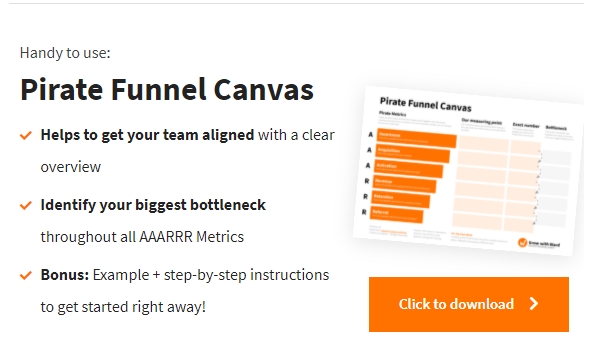
screenshot from growwithward.com
4. Gamification
While giveaways, discounts and download campaigns also support brand awareness because they foster a certain level of engagement, gamification campaigns increase lead engagement tenfold.
Again, it’s not one of the easiest ways to generate leads, but it’s more powerful than the first three.
What is gamification in marketing?
Gamification marketing is increasing engagement by incorporating gaming principles into your campaign. Gamification is psychology-based and taps into your lead’s reward centre of their brain.
Essential key points that you should take into consideration when developing your landing page:
- Bright and attractive colours to pique the curiosity of your lead;
- The game should be simple enough to understand and complex enough to stimulate the lead’s innate competitiveness;
- Invite your leads to complete the contact information form only after they’ve entered the game and are eager to finish it;
- Refrain from making the game too long;
- Give your players incentives to move on to the next stage by unlocking rewards or achievements.
Here’s a great example called Wheel of Security, a lead-generation game developed by Juniper Network:
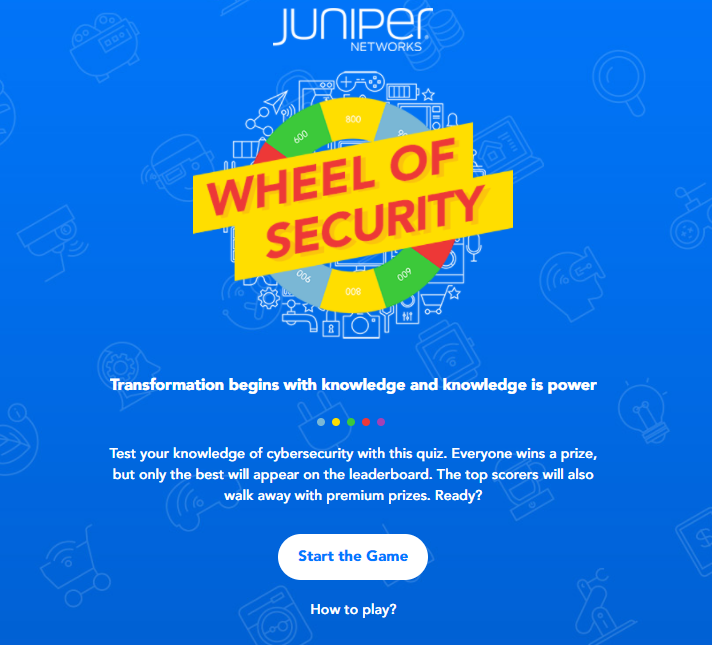
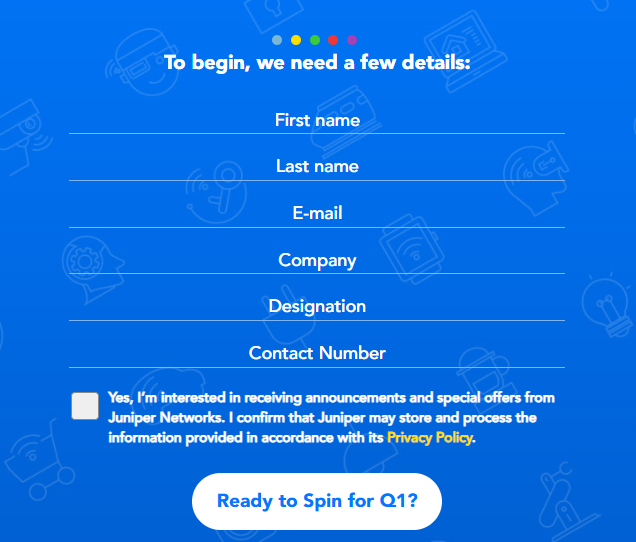
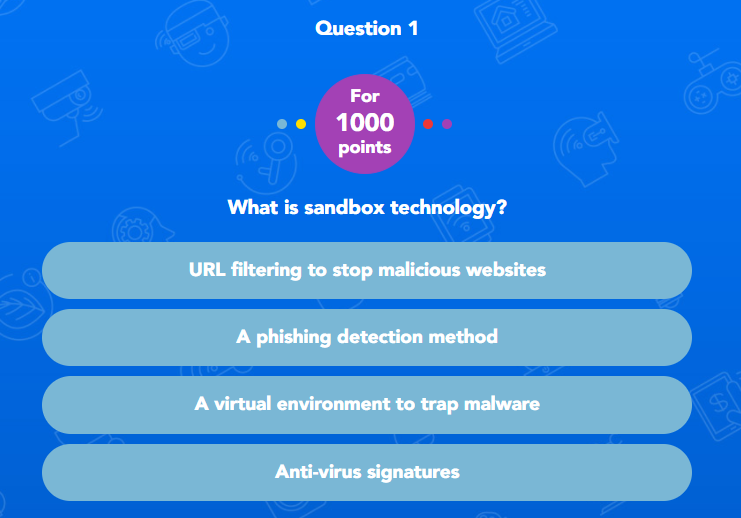
5. Referral programs
Referral programs work splendidly in two ways: they delight your customers and provide them with a mechanism to send you new leads.
Basically, your existing customers are doing your work for you. But you need to provide them with the right tools.
Your referral program landing page should include:
- An enticing image;
- Headline and body copy;
- Clearly list what your customer will get by sharing your brand or product with their friends;
- Clearly state what their friends will get;
- Allow your customers to share your offer easily;
- CTA button.
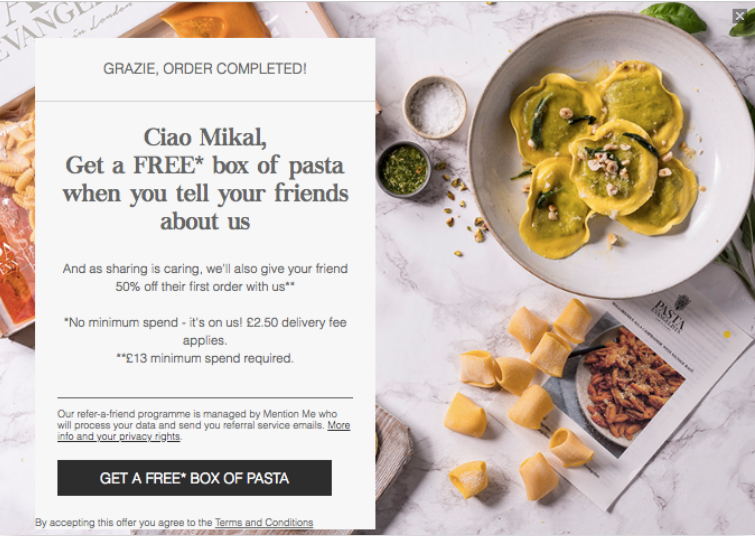
screenshot from pastaevangelists.com
Want to get top insights for high ROI campaigns?
Subscribe to our blog newsletter!
10 Growth Marketing Tactics To Grow Your Business
Are you looking to grow your business?
Read on to discover 10 growth marketing tactics!
10 Growth Marketing Tactics To Grow Your Business
Growth Marketing Tactic #1 – Sniply
Would you like to increase your conversion rates? Sniply is a great tool to achieve this goal.
Sniply is a simple tool that allows you to overlay your own custom message onto any piece of content, creating an opportunity for you to include a call-to-action with every link you share.
People use Sniply to drive conversions from every piece of content they share. You can drive traffic to your website, downloads of your app, registrations for your event, customers for your service, and more.
I created my first snip in 2 minutes and I chose to place it on one of Seth Godin’s blogs as you can see below:
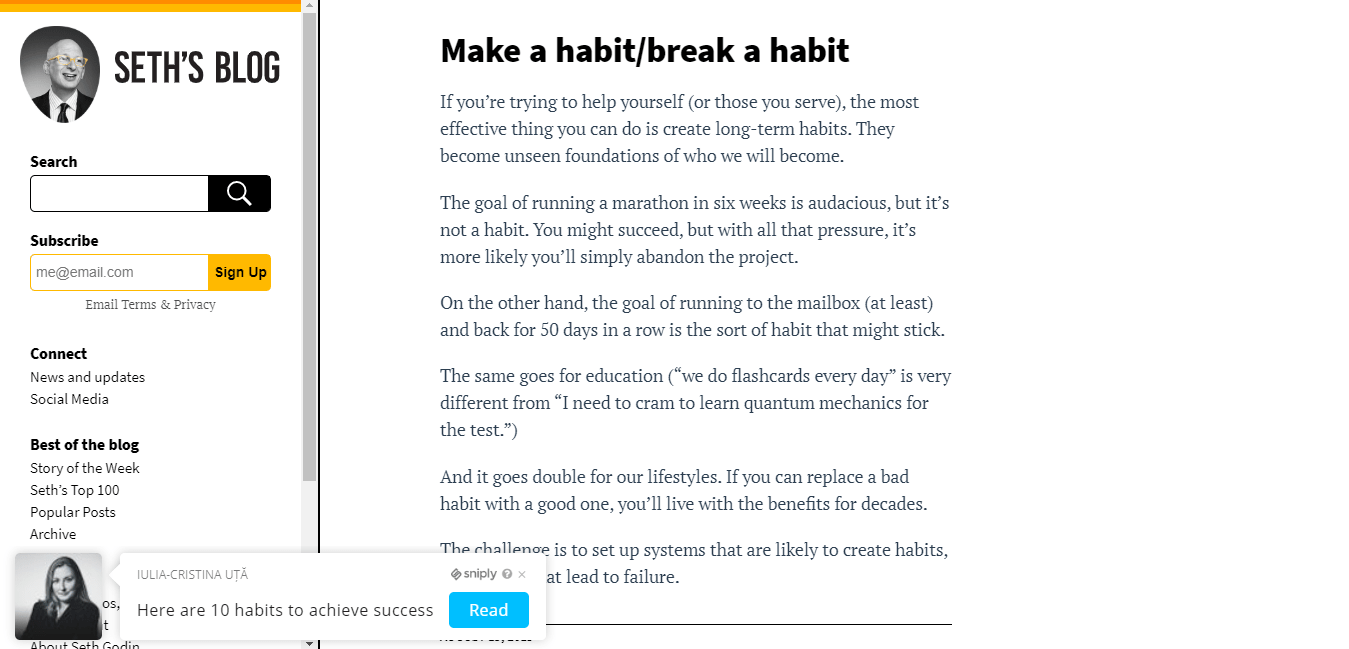
Key takeaways:
- Make sure the page which hosts your snip and the page your snip sends visitors to match ie your content is relevant to the visitors of the host page;
- Create a clever CTA.
Growth Marketing Tactic #2 – LinkedIn Engagement Pods
Engagement pods started on Instagram and in recent years migrated to LinkedIn.
What are LinkedIn Engagement Pods?
LinkedIn Engagement Pods are private groups of Linkedin users who are all focused on engaging in and sharing other people’s LinkedIn content.
It’s a way to boost your post’s visibility on LinkedIn. This engagement gives your post a little nudge in the right direction but only if it’s high-quality content.
LinkedIn Engagement Pods can amplify your brand’s reach and provide you with opportunities for improved networking and/or collaboration.
If your company employs a large number of people, creating a Company LinkedIn Engagement Pod could empower your employee to become advocates on social.
Key takeaway:
- Choose your LinkedIn Engagement Pod carefully;
- Write content relevant to the pod’s members.

Growth Marketing Tactic #3 – Thank-you tags or coat-tailing
You post your piece of content and it starts receiving likes from the people in your network. What do you do when someone gives you something? You say ‘Thank you!’.
The same courtesy should apply online too. Growth Marketer Jeff Deutsch encourages marketers to say ‘Thank you’ in the comments of their posts and tag the people who liked them.
Why is it a growth tactic?
Because LinkedIn or Facebook or Twitter will show the posts where these people are tagged to other people in that person’s network which leads to increase visibility.

Growth Marketing Tactic #4 – Place the link to your article in the first comment
Every social network wants to keep you connected on its platform. That’s why all social platforms encourage and value engagement (likes, comments, shares) and frown upon posts with links that allow users to leave their digital space.
Posts with links receive less visibility than posts with no links. You have spent three to four hours carefully crafting your blog and you would like people to read it and rightfully so. But if you cannot place the link in your post what can you do?
You have two options:
- Publish the post with no link then edit it to include the link;
- Publish the post with no link but place the link in your first comment.
It’s been a week since I implemented this tactic and my posts with links in the first comment received increased visibility jumping from 50 views to over 400 views overall. That’s a 6x increase in visibility!
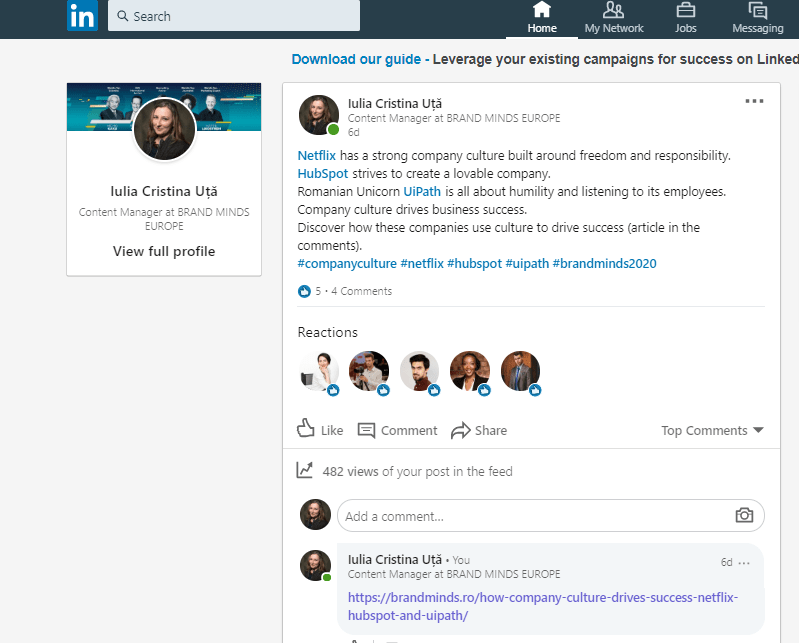
Growth Marketing Tactic #5 – Post native video on LinkedIn, Facebook, YouTube, Instagram and Twitter
Video is the best way to engage authentically with your customers. Although not everyone feels comfortable talking in front of the camera it’s a great way to get your customers to know you and build a connection.
All social media networks now allow users to post native videos. They encourage users to upload videos directly or go live on their platforms. As a result, video posts receive increased visibility.
Here are 10 smart ideas for video content you can use on LinkedIn and 10 Ideas to use Facebook Live in your Communication Strategy
Growth Marketing Tactic #6 – Pixel your visitor
Growth marketer Jeff Deutsch has this tip for marketers running Facebook ads: pixel your visitor, not your landing page.
Instead of placing your Facebook pixel on your landing page, place it on a blank HTML page. This page will pixel your visitors and redirect them to your landing page.
What does this tactic solve?
It tags people who leave before your landing page has loaded because they either lack patience or your landing page has a number of scripts that extend the loading time.
Jeff states this tactic is a way to stop losing 30% of your ad traffic.
![]()
Growth Marketing Tactic #7 – Facebook Messenger hack – the Auto-responder
Over 1 billion people use Messenger to connect with businesses every month.
MobileMonkey CEO Larry Kim found a way to take this opportunity to the next level: auto-responders.
In his article, Larry shows how to grow your Messenger subscription base with an auto-responder chatbot called Comment Guard.
Growth Marketing Tactic #8 – Gamification
Famous marketer Neil Patel lists gamification as a growth marketing tactic.
He recommends marketers to use gamification to their advantage by pulling their audience in with quizzes and polls to spark engagement and brand awareness.
To leverage gamification, marketers have to make content entertaining while also providing value.
According to Neil, gamified systems must tick three boxes:
- Give users motivation to do something (emotional investment, the promise of reward, etc.);
- The ability to complete the action;
- Provide a trigger or cue to complete the action.
Growth Marketing Tactic #9 – Piggyback on a thriving network
In 2016, Spotify integrated with Facebook Messenger allowing people to share their Spotify songs or playlists directly within a chatbox. This integration accelerated Spotify’s growth through referral traffic. Ultimately, millions of Facebook users also became advocates of the music platform because it filled the users’ desire to share their music socially.
Airbnb’s integration with the Craiglist platform is now the company’s most famous growth hack. In 2010, looking to access Craiglist’s huge user base, Airbnb built a bot to piggyback the platform. Check out the Airbnb growth case study.
What is the secret of successful integration with another platform?
Start with the perfect experience and work backwards.
Growth Marketing Tactic #10 – H.A.R.O
H.A.R.O. stands for Help A Reporter Out.
Help A Reporter Out is a media services company with over 35,000 journalists and 800,000 source members which started out as a Facebook group.
HARO allows sources to find topics related to their expertise, industry or experience while allowing journalists and bloggers to spend more time writing and less time sourcing. Subscribe as a source and you could be featured in mainstream media.
It’s a long-term effort but the potential benefits are worth it: increased brand awareness, augmented SEO, building business opportunities, establishing leadership credibility and garnering high levels of engagement on social.
What growth marketing tactics do you employ to grow your business?
Join the Conversation
We’d love to hear what you have to say.
Get in touch with us on Facebook Group and Twitter.
Top trends in shopper marketing in 2018
With a more and more savvy consumer and digital and technology re-shaping it, shopper marketing became in the last years almost a science, relying a lot on research and customer observation. While in the US, the Shopper Marketing magazine developed a very strong research on this year’s trends that can be read here, we asked 3 local advertising specialists to give us their thoughts as well.

Cristina Oncescu, Head of Strategy pastel
What do you believe will be the biggest shopper marketing trends of 2018?
I don’t know if they are the biggest, but they are certainly hot in 2018:
- Personalised shopping
There are many in-store technologies that can be used to provide a personalised shopping experience. NFC (Near Field Communication) chips, QR codes, iBeacons and Visual Light Communications are just some of the emerging technologies used. These, when linked to previous shopping histories via a loyalty app for instance, can provide disruptive yet compelling interactions with the shopper as they enter the store.
- Virtual assistance
From voice to chatbots, going through messenger apps, one-to-one communication is on the rise. Being available and being helpful, when the shopper needs you, is making the difference.
- Augmented Reality
The use of Augmented Reality on mobile devices provides an engaging way for marketers to reach their target audience – it’s quick, easy and very interactive. With the integration of AR on iPhones, it will be easier for marketers to engage larger audiences during their path to purchase.
What are they influenced by and why?
Technology, and especially mobile, led shoppers becoming more and more omnichannel. Now, this is an actual behaviour that the shoppers engage in (of course in a subconscious way). Web, mobile, social, apps – it’s all just shopping to consumers. The separation between retail channels is growing even more blurred by the day. Can they return online products in-store? Can they check if the store has their size and colour on their mobile phone before they leave their homes? Consumers expect a seamless experience across all channels.
What is pastel advising its clients this year?
Great content will always engage. Have an interesting, consistent story and a seamless experience throughout the whole omnichannel path to purchase.

Anton Gherca, Chief Innovation Officer at g7
What do you believe will be the biggest shopper marketing trends of 2018?
We believe that shopper marketing is an area of brand communication that has been kept largely untouched by the digital revolution that is reshaping the advertising industry for the past 10 years. So we expect that „digital BTL” will start gaining momentum, as today’s practices are deeply engrained in traditional approaches of point of sale communication. We think that we will see more connections between social media and shopper marketing, and geofencing and point of sale promotions, with the aim of delivering a more integrated omnichanel shopper experience.
What are they influenced by and why?
Like many things in advertising, the move towards a more „digital” shopper marketing approach is driven by the consumers themselves, or more precisely, by their lifestyle. As of 2017, the penetration rate of smartphones in Romania is 70%, while 41% of the population are already mobile social users. Peer-to-peer ridesharing like Uber makes people understand the benefits of the sharing economy, on-demand services like Netflix put them in the driver’s seat while the wide 4G coverage makes them want everything now. This means people are getting more and more accustomed to having everything at a push of a button and they expect higher levels of service, increased transparency, embedded interactivity and all in all a better customer experience out of everything.
I know this sounds like a bunch of buzzwords cramped togheter in one sentence, and our agency has never been in the „buzz” business, but the reality is that the shift in consumers’ lives is happening with or without us. I think the bottom line is that today’s shoppers are just expecting something more out of marketing communications. More relevance, more engagement, more customization. This doesn’t mean that we, the shopper marketers, can’t still get away with the old „buy one – get one” or „scratch this to win a prize that you don’t even want” mechanics. But wouldn’t that be a pity?
What is g7 advising its clients this year?
Our agency has embarked in a digital transformation journey and once set in motion, it can’t be stopped. We will continue an initiative started in 2017, of hosting periodic innovation workshops together with our clients for identifying the opportunities put forth by today’s technology, and see where that gets us. Still, there are a couple of areas we keep tightly in our focus: Proximity marketing, Loyalty management and Gamification. We work towards integrating in an organic manner these three capabilities in the approach our clients are already used to: honest creative work, deep understanding of shopper behavior and solid deployment in the retail ecosystem.

Ondina Olariu, Business Director Geometry Global
“Fragmentation, increased competition and e-commerce are key words for 2018 and beyond in our region. After seeing a huge expansion, somewhat even inflated for some of the retail players, we will witness a new battleground, named proximity. As global retailers keep expanding, we will live through a great variety of formats, more flexibility and adaptation to micro-retailing needs. Proximity will be influenced as well by the increasing degree of urbanization, as well as the new generations of shoppers, more dynamic, digital savvy and format switchers (in Romania, 25 cities cover 31.3% of total population and 55.6% of urban population – source: INS, Romania, 2017).
And when we say flexibility and adaptation, think beyond format, as we see discounters aggressively stepping in the services territory, while share of consumer spend reached 68% in services vs 32% in goods in 2016 (source: Kantar Global Trends 2018). Goods subscription – meaning bundle goods as a service is something that we preached our clients for a couple of years already and it’s approaching it’s turning point in 2018.
E-commerce in Europe is predicted to reach 10% of total retail (source: Kantar 2018 Global Predictions, WPP Data), with a clear future towards what we call omni-channel, especially since gen Z takes the scene as newest shoppers. At global level we see the switch and struggle of most pure e-commerce players in becoming physical as well, to the level where blogs impersonate the physical space in temporary shops where experience blends with sales, while in Europe we are taking steps into developing the brick-and-mortar into e-commerce, especially for FMCG area, which are the most shopped for categories. Retailers will continue or start monetizing opportunities through their own apps, following the evolution of more mature markets, such as Spain (+210% in app sessions growth in the last 2 years) or Germany (+130%). Here again, it seems that pure digital players have a degree of advancement, since digital-first retail apps saw more that 2x the average sessions / user each month and saw stronger growth in the last 2 years. (source: App Annie 2017 retrospective report). This means we will see accelerated growth for digital players apps, as the new arrivals from physical retailers will need to extract good lessons and apply on fast track.
Blending online and offline expresses also in automation, such as automated cashiers. As retailers will increasingly see value, watch for a retail unemployment crisis, especially in more mature markets. The proliferation of private labels will increasingly force out brands from the physical shelf. Most of these private labels continue to be supported as brands rather than price options, from food to fashion (see Esmara for Lidl and Tex for Carrefour) and home appliances (eg Carrefour Home consumer electronics). Health and Wellness is an increasingly appealing theme, for both brands and retailers. Watch the shelf space growth in store, as well as the latest positioning of certain private labels, trying to capture value and exploit the trend.
As a shopper agency, we are not only advising but already working with our clients on the omni-channel shopper journey models, including retailer strategies and new channels opportunities in this process. We build with them strong e-commerce fundamentals for the Romanian market and expand to e-commerce experiences and integration of channels for more mature markets. We operate with an increasingly complex model that includes data management and A/B testing applied to shopper initiatives and integrate thorough shopper knowledge in every solution we bring to the table. Bonus: an emerging trend, still less visible to this market is the return to D2C (Direct to Consumer). It will be highly influenced by retailers’ behavior, however, more brands become conscious they cannot rely exclusively on retailers and distributors in building their relationship with shoppers and consumers, therefore they’ll be trying to find ways to cut it short to them and bypass the “official” channels.”
